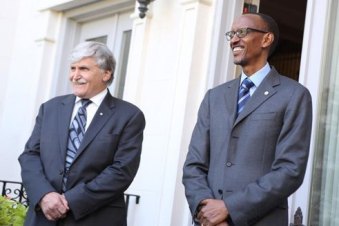The United Nations deployment to Rwanda seemed like a straightforward peacekeeping mission back in 1993.
A lightly armed force of approximately 2,500 peacekeepers would help implement the Arusha Agreement, a 1993 peace accord that ended the civil war between Rwanda’s Hutu government and the Tutsi liberation movement, the Rwandan Patriotic Front.
Instead of overseeing national reconciliation, U.N. soldiers became eyewitnesses to genocide.
Disregarding the 1993 Arusha Accord, Hutu forces began to target Tutsis for extermination after a plane carrying Rwandan President Juvénal Habyarimana crashed on the evening of April 6, 1994. In the power vacuum created by his death, Rwanda’s Hutu political elite launched a long-planned campaign of genocide.
As the mass killings began, the U.N. ordered its blue helmeted troops to evacuate foreigners – but not intervene to save the Tutsis from slaughter. Between 800,000 and 1 million Tutsi and non-extremist Hutu civilians were murdered by their own neighbors.
A 1999 U.N. report assessing the the Rwanda deployment called the mission “disgraceful” for abandoning Tutsi refugees in schools and other supposed “safe zones” they had created.
“Troops were withdrawn when they were most needed,” said former U.N. chief Ban Ki-moon in 2014. “We should have done much more.”
Earlier this year, I interviewed former U.N. peacekeepers who served in Rwanda who had returned the country for the 25-year commemoration of the genocide. I learned that despite the broader mission’s many well-documented failings, peacekeepers took risks to save lives, going beyond official orders to protect innocent Rwandans.
1. Diplomacy worksThe Rwandan peacekeeping mission, like U.N. peacekeeping in general, suffered from having a very narrow mandate.
Officially, peacekeepers are tasked by the U.N. security council with monitoring, assisting and investigating crimes and violence. Soldiers may only use force in self defense or to help evacuate foreigners.
This limited mandate put soldiers in an impossible situation when genocide began in April 1994. Some soldiers felt a moral obligation to intervene when they saw civilian killings.
Peter Sosi, a retired army major from Ghana, lead a unit that aided Tutsis who’d fled their homes and sought refuge in a hotel that later fell under the control of a genocidal Hutu militia known as the Interahamwe.
Sosi and his soldiers needed to evacuate more than 200 civilians to a U.N. safe zone in the city. To do so, he had to negotiate passage with the Hutu child soldiers staffing a roadblock in Kigali.
The U.N. had provided no guidance on negotiating with perpetrators of violence against civilians. So Sosi got creative: He offered the soldier in charge of the roadblock a can of cold Coca-Cola, hoping the small gift would relax the young commander enough to allow a conversation.
“And the Coca-Cola diplomacy actually worked!” Sosi told me. “We had passage to the hotel with little resistance.”
Major Sosi’s actions reflect a strategy I heard repeated in my other interviews: Creative diplomacy saves lives.
2. Culture mattersU.N. peacekeepers are soldiers from across the globe. Before they are sent to patrol countries quite different than their own, troops are briefed on cultural awareness.
But there is often a disconnect between official training and local reality, peacekeepers told me, especially in rural areas. And cultural misunderstandings can create mistrust that jeopardizes the peacekeepers’ life-saving mission.
“It is a culture of Canadian peacekeepers to ‘adopt’ an orphanage and provide what we can to the children,” Warren Webber, a Canadian peacekeeper who served in Rwanda, told me.
His peacekeeping division partnered with an orphanage near Butare, Rwanda, in June 1994, successfully protecting resident children through the final weeks of the genocide.
3. Actions speak louder than wordsThe Canadian troops’ “adoption” of Rwandan orphanages highlights a third factor that can make peacekeeping missions more successful: community engagement.
The U.N. troops’ involvement with kids showed local Rwandans that despite having formal uniforms, unfamiliar language and, in most cases, a different skin color, the U.N. soldiers were more relatable than they seemed: They loved children; they had a human side.
In a conflict that pitted neighbor against neighbor, such behavior created bonds between victims and peacekeepers and generated trust – key ingredients to working in conflict zones, where social trust is threatened, likely broken.
In war, trust can mean the difference between life and death.
Learning from RwandaTwenty-five years after genocide occurred in Rwanda on the United Nations’ watch, 102,736 military and civilian personnel serve in 14 active peacekeeping missions worldwide.
U.N. blue helmets are deployed to prevent flare-ups of hostilities and ensure access to humanitarian aid in Lebanon, protect civilians from genocide in Darfur and strengthen the police and prison system of post-earthquake Haiti.
Along with sustained initiatives to reform the U.N.‘s peacekeeping apparatus, these critical missions and others would be greatly strengthened by re-examination of the minor miracles worked in Rwanda.
Dispatched with a fatally timid mission, many ordinary U.N. soldiers in Rwanda took extraordinary actions, using diplomacy, cultural awareness and community engagement. Their actions saved close to 30,000 lives, according to Romeo Dallaire, who led the U.N.’s deployment in Rwanda.
Learning from what actually worked on this famously failed mission can save lives in the future.
